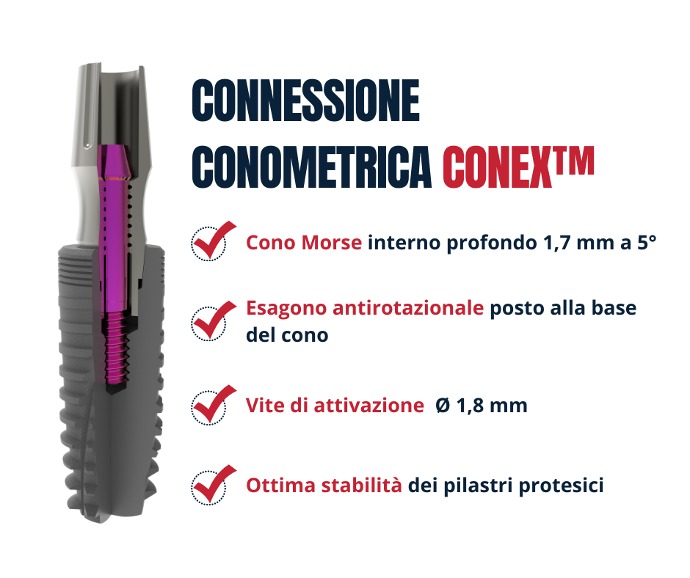The screwed connection has always been a major player in implantology. However, the Morse taper connection offers numerous advantages, allowing the use of simple but effective techniques that eliminate micro-movements of the abutment, eliminate unscrewing of the abutment and eliminate the risk of bacterial infiltration at the abutment-implant interface.
Continue reading this in-depth article on the Morse taper to discover its characteristics, angulation degrees and advantages!
Summary
1. What is a Morse taper and what characteristics does it have to have?
2. What are the degrees of angulation to determine that it is a Morse taper?
3. Can a device with a 2° angle be defined as a Morse cone?
4. The ConEx™ taper connection: the BioService implant line synonymous with precision and reliability
What is a Morse taper and what characteristics does it have to have?
The Morse taper consists of a conical surface (die) with a certain inclination, which fits onto a corresponding conical surface (patrice) on another part of the equipment. This configuration allows a tight and stable fit between the two parts.
To connect two parts with Morse cones, a force is applied to adhere the conical surfaces (die and male) together. Generally, to separate the parts, an extractor or hammer is used to break the adhesion of the conical surfaces and allow them to be removed.
The main features of the Morse taper include:
- conical shape: the Morse taper has a conical shape that allows a stable fit between the matrix and the male;
- dimensional accuracy: must be produced with precise tolerances in order to ensure a secure and stable fit between the matrix and the male;
- resistant materials: must be made of robust and wear-resistant materials in order to withstand the forces and temperatures generated during use;
- smooth surface: the surface of the Morse taper must be finely machined to ensure uniform contact and reduce wear during use;
- ease of assembly and disassembly: it must be designed to allow easy assembly and disassembly between the matrix and the male.
What are the degrees of angulation to determine that it is a Morse taper?
- Standard Cone Morse (CM), with an inclination angle of 5.18629 degrees;
- Japanese Cone Morse (JIS), with an inclination angle of 5.575 degrees.
Can a Morse taper be defined as a device with a 2° angle?
However, there are devices with different tilt angles that do not fall into the standard category of Morse cones. They may be used for specific or customised purposes, but are not considered ‘Morse cones’ in the traditional sense.
If you have a device with an angle of two degrees and you want to identify it correctly, you may need to determine whether it corresponds to a specific standard or whether it is a customised or unconventional device.
The ConEx™ taper connection: the BioService implant line synonymous with precision and reliability

It is precisely because of the tight fit between implant and abutment (Fixture and Abutment) that the Morse taper connection brings a number of advantages, such as:
- no micromovements;
- excellent stability of prosthetic abutments;
- elimination of the unscrewing of the through-screw;
- no unsightly holes;
- optimal soft tissue management in the peri-implant area at the crestal level;
- elimination of bacterial infiltrates.
Equally advantageous is the tapered prosthesis, an alternative technique to the more traditional screw-retained and cemented approaches that uses the same coupling principle as the tapered connection.
How does it work, what are its features and why is it so effective? Don't miss BioService's next article on this very topic!

